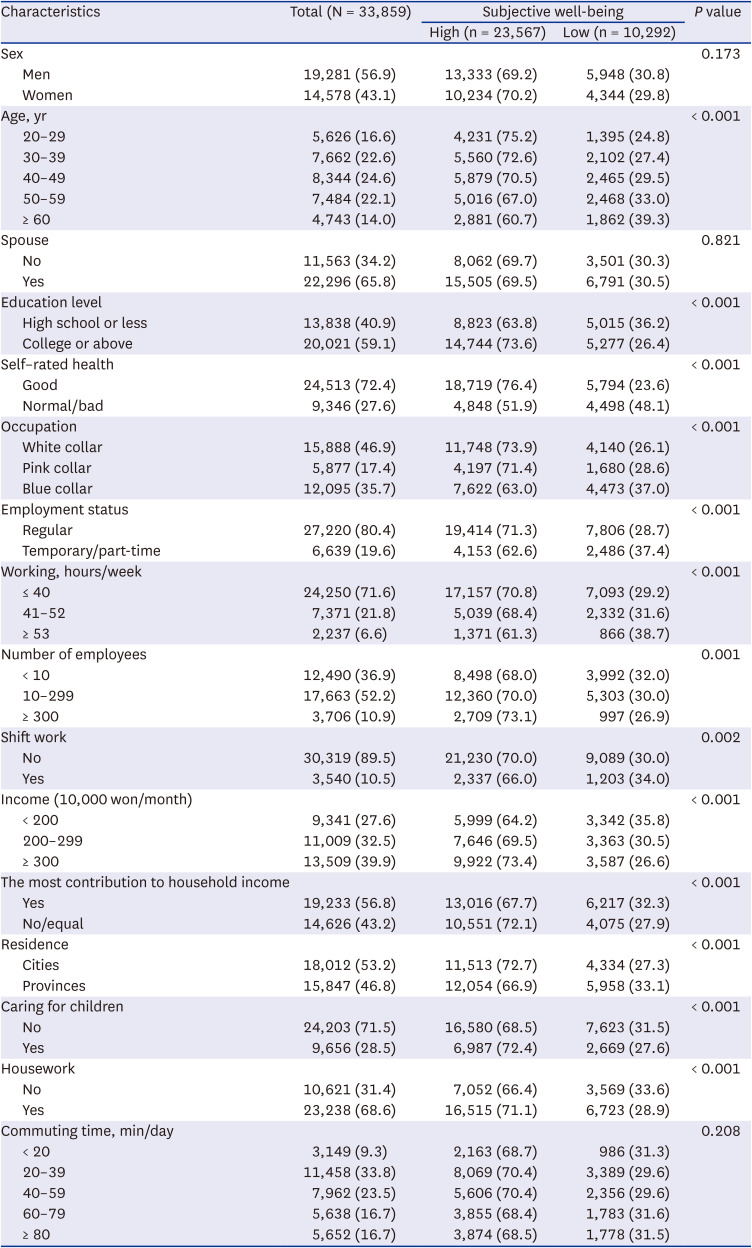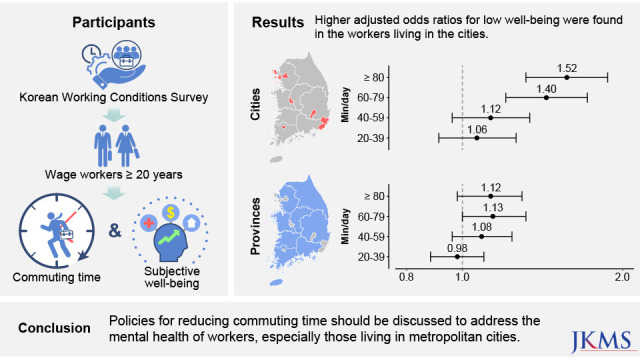1. Bissell D. Transit Life: How Commuting Is Transforming Our Cities. Cambridge, MA, USA: The MIT Press;2018.
2. Lyons G, Chatterjee K. A human perspective on the daily commute: costs, benefits and trade-offs. Transp Rev. 2008; 28(2):181–198.
3. Zijlstra T, Verhetsel A. The commuters’ burden: the relationship between commuting and wellbeing in Europe. Travel Behav Soc. 2021; 23:108–119.
4. Kahneman D, Krueger AB, Schkade DA, Schwarz N, Stone AA. A survey method for characterizing daily life experience: the day reconstruction method. Science. 2004; 306(5702):1776–1780. PMID:
15576620.
5. Hahad O, Prochaska JH, Daiber A, Muenzel T. Environmental noise-induced effects on stress hormones, oxidative stress, and vascular dysfunction: key factors in the relationship between cerebrocardiovascular and psychological disorders. Oxid Med Cell Longev. 2019; 2019:4623109. PMID:
31814877.
6. Gottholmseder G, Nowotny K, Pruckner GJ, Theurl E. Stress perception and commuting. Health Econ. 2009; 18(5):559–576. PMID:
18709637.
7. Hämmig O, Gutzwiller F, Bauer G. Work-life conflict and associations with work- and nonwork-related factors and with physical and mental health outcomes: a nationally representative cross-sectional study in Switzerland. BMC Public Health. 2009; 9(1):435. PMID:
19943980.
8. Wang X, Rodríguez DA, Sarmiento OL, Guaje O. Commute patterns and depression: evidence from eleven Latin American cities. J Transp Health. 2019; 14:100607. PMID:
31853443.
9. Milner A, Badland H, Kavanagh A, LaMontagne AD. Time spent commuting to work and mental health: evidence from 13 waves of an Australian cohort study. Am J Epidemiol. 2017; 186(6):659–667. PMID:
28453601.
13. Pucher J, Korattyswaropam N, Mittal N, Ittyerah N. Urban transport crisis in India. Transp Policy. 2005; 12(3):185–198.
14. Cramer V, Torgersen S, Kringlen E. Quality of life in a city: the effect of population density. Soc Indic Res. 2004; 69(1):103–116.
15. Hoare E, Jacka F, Berk M. The impact of urbanization on mood disorders: an update of recent evidence. Curr Opin Psychiatry. 2019; 32(3):198–203. PMID:
30676331.
16. Werneck AO, Silva DR. Population density, depressive symptoms, and suicidal thoughts. Br J Psychiatry. 2020; 42(1):105–106.
20. Jin J, Jin E, Kim D. Commuting time and happiness in Seoul. J Korea Plan Assoc. 2017; 52(2):99–116.
21. Ko EJ, Jeon SB. The quality of life and commuting: considering time - use and income of Kyunggi resident. GRI Rev. 2017; 19(3):25–49.
22. Jeon H, Jin JM. Analyzing effects of commuting time on subjective life satisfaction and its values by household type and gender for the Seoul residents. Seoul Stud. 2020; 21(3):87–100.
23. Kim S, Kim Y, Lim SS, Ryoo JH, Yoon JH. Long commute time and sleep problems with gender difference in work–life balance: a cross-sectional study of more than 25,000 workers. Saf Health Work. 2019; 10(4):470–475. PMID:
31890330.
24. Topp CW, Østergaard SD, Søndergaard S, Bech P. The WHO-5 Well-Being Index: a systematic review of the literature. Psychother Psychosom. 2015; 84(3):167–176. PMID:
25831962.
26. Stutzer A, Frey BS. Stress that doesn’t pay: the commuting paradox. Scand J Econ. 2008; 110(2):339–366.
27. Nie P, Sousa-Poza A. Commute time and subjective well-being in urban China. China Econ Rev. 2018; 48:188–204.
28. Christian TJ. Trade-offs between commuting time and health-related activities. J Urban Health. 2012; 89(5):746–757. PMID:
22689293.
29. Hilbrecht M, Smale B, Mock SE. Highway to health? commute time and well-being among Canadian adults. World Leis J. 2014; 56(2):151–163.
30. Kang SH, Boo YJ, Lee JS, Han HJ, Jung CW, Kim CS. High occupational stress and low career satisfaction of Korean surgeons. J Korean Med Sci. 2015; 30(2):133–139. PMID:
25653482.
31. Hansson E, Mattisson K, Björk J, Östergren PO, Jakobsson K. Relationship between commuting and health outcomes in a cross-sectional population survey in southern Sweden. BMC Public Health. 2011; 11(1):834. PMID:
22039952.
32. Dzhambov A, Tilov B, Markevych I, Dimitrova D. Residential road traffic noise and general mental health in youth: the role of noise annoyance, neighborhood restorative quality, physical activity, and social cohesion as potential mediators. Environ Int. 2017; 109:1–9. PMID:
28917129.
33. Novaco RW, Kliewer W, Broquet A. Home environmental consequences of commute travel impedance. Am J Community Psychol. 1991; 19(6):881–909. PMID:
1793097.
34. Clark B, Chatterjee K, Martin A, Davis A. How commuting affects subjective wellbeing. Transportation. 2019; 47(6):2777–2805.
35. Roberts J, Hodgson R, Dolan P. “It’s driving her mad”: gender differences in the effects of commuting on psychological health. J Health Econ. 2011; 30(5):1064–1076. PMID:
21855154.
36. Yang SN, Shin CS. Work-family conflicts: challenges of working mothers with young children. Pogon Sahoe Yongu. 2011; 31(3):70–103.
37. Ju YJ, Park EC, Ju HJ, Lee SA, Lee JE, Kim W, et al. The influence of family stress and conflict on depressive symptoms among working married women: a longitudinal study. Health Care Women Int. 2018; 39(3):275–288. PMID:
29095122.
38. Peen J, Schoevers RA, Beekman AT, Dekker J. The current status of urban-rural differences in psychiatric disorders. Acta Psychiatr Scand. 2010; 121(2):84–93. PMID:
19624573.
39. Han C, Kim S, Lim YH, Bae HJ, Hong YC. Spatial and temporal trends of number of deaths attributable to ambient PM
2.5 in the Korea. J Korean Med Sci. 2018; 33(30):e193. PMID:
30034305.
40. Haider M, Kerr K, Badami M. Does commuting cause stress? the public health implications of traffic congestion. SSRN Electron J. 2013; August. 3. DOI:
10.2139/ssrn.2305010.
41. Zijlema WL, Klijs B, Stolk RP, Rosmalen JG. (Un)healthy in the city: respiratory, cardiometabolic and mental health associated with urbanity. PLoS One. 2015; 10(12):e0143910. PMID:
26630577.
42. Zijlema WL, Avila-Palencia I, Triguero-Mas M, Gidlow C, Maas J, Kruize H, et al. Active commuting through natural environments is associated with better mental health: results from the PHENOTYPE project. Environ Int. 2018; 121(Pt 1):721–727. PMID:
30321847.
43. Jansen NW, Kant I, Kristensen TS, Nijhuis FJ. Antecedents and consequences of work-family conflict: a prospective cohort study. J Occup Environ Med. 2003; 45(5):479–491. PMID:
12769054.
44. Lee Y, Lee S, Kim YJ, Kim Y, Kim SY, Kang D. Relationship between of working hours, weekend work, and shift work and work-family conflicts among Korean manufacturers. Ann Occup Environ Med. 2022; 34(1):e20. PMID:
36147589.
45. Martin A, Goryakin Y, Suhrcke M. Does active commuting improve psychological wellbeing? Longitudinal evidence from eighteen waves of the British Household Panel Survey. Prev Med. 2014; 69:296–303. PMID:
25152507.
47. Dickerson A, Hole AR, Munford LA. The relationship between well-being and commuting revisited: does the choice of methodology matter? Reg Sci Urban Econ. 2014; 49:321–329.








 PDF
PDF Citation
Citation Print
Print




 XML Download
XML Download